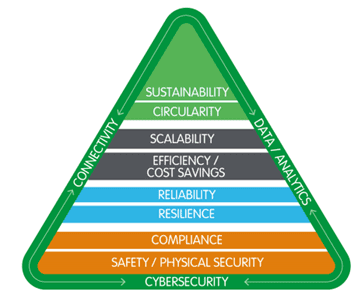In an increasingly connected world, data is the currency with which we operate. For companies of all shapes and sizes, connectivity — and the resulting data it provides — is what allows them to elevate performance and reach critical business outcomes ranging from safety and compliance to resilience and reliability, from efficiency and optimization to sustainability and circularity.
However, in speaking to two IT experts, one from a large global enterprise and the other from a local smaller enterprise, I found that digital transformation is often overwhelming for many companies — and always ongoing. What are the basic necessities for collecting data? How can organizations make sure data is structured and gathered in such a way that it can be made useful? Who can manage digitization among external pressures from customers and investors to stick to their wheelhouse? Many companies feel like they’ve missed the boat on digitization, but in fact, it’s a journey that will keep evolving for many years to come. Often, this overwhelming feeling results in urgent questions.
In my conversation with the two IT experts, we discussed three lessons about digital transformation, and how external services can help companies achieve operational and critical business outcomes they’re striving toward.
Lesson #1: Digitization is key for avoiding the worst-case scenario
Picture this. You’re packed and ready to board your flight, kicking off a much-needed vacation. Suddenly, the power cuts out in the airport — and everything shuts down. More than 1,180 flights are cancelled, and 30,000 passengers are stranded for over 10 hours with no power.
This is exactly what happened at one of the country’s busiest airports in late 2017 after an electrical fire damaged two substations serving the airport, including one that should have provided backup power. Could this have been prevented? To some extent, yes — with digitization. Better connectivity between systems could have helped avoid this worst-case scenario.
In this example, officials weren’t sure of the initial cause of the fire and electrical experts weren’t able to investigate until after the fire was extinguished. Perhaps the disaster could have been prevented if authorities had insight or warnings into the problem earlier through better connectivity. This is a prime example of the value of digital monitoring and having the right data at the right time. Human failure is often a part that gets overlooked in these situations. Companies have to be more inquisitive of who is managing certain equipment and making sure the right people have access. There’s nothing “routine” about working on the guts of important and complex equipment, so having visibility into who is maintaining equipment is key.
Lesson #2: Critical business outcomes — from compliance and safety to resilience to sustainability — are more in demand
As digital transformation has evolved, I kept hearing from IT leaders, facility directors, engineering and others, a focal point on delivering critical business outcomes versus simply focusing on equipment maintenance and lifecycle — whether that’s making sure they’re compliant or looking to scale, for example. Without connectivity, data, and cybersecurity, those outcomes aren’t possible. We presented these aspects in an outcome pyramid — almost like Maslow’s Hierarchy of Needs — where basics like safety are at the bottom, while sustainability is the ultimate apex at the peak. Safety and compliance are fundamental outcomes for every company, but operational excellence, meaning efficiency and resilience, have become very important.

At a large enterprise, they really need a unified architecture that allows them to connect the various layers of equipment. They also need to work with their suppliers to do that. A plug-and-play connectivity provides remote data for better control over operational outcomes.
For a smaller local enterprise, critical business outcomes are aspirational goals, and to achieve them, it’s all about simplicity. Their data team is often “one person”. How do they move forward and convince their organization that they need to be focusing on these outcomes? It’s talking to other people and trying not to reinvent the wheel. The solution and process need to be simple — whether it’s gathering the data or implementing it. Without simplicity, it’s hard for a small enterprise application to achieve any critical business outcomes.
Lesson #3: Digital services lessen the burden on companies to achieve operational outcomes
Digital transformation is essential for companies to evolve, become more efficient, and achieve critical business outcomes. But for many organizations, it’s still very hard to do — why?
First and foremost, digitizing machines, buildings, and processes is not the core competency for most companies. It can be costly, and many organizations have external pressures to focus on the core business and revenue-producing activities, versus tinkering with digitization. That’s where Schneider Electric Services can help.
By outsourcing digital services to a partner like Schneider Electric, companies can focus their efforts where needed without having to worry about things like the security of their data, how it’s being structured, and how they need to execute. Digital services provide these aspects to support companies, but they still make the final decisions in the end — we’re simply providing the data to back it up.
For a small enterprise, it’s very hard to implement everything you want to, so reliance on partners is critical. That’s where a partner like Schneider Electric would come in and say, ‘Hey, we know you’re small, but have you thought about this solution?’”.
Both IT experts also agreed that the whole idea of digitization — weaving multiple systems together, adding additional assets, and extracting exactly what you need out of the data — is hard. Having a partner to help you figure it out, as complexities continue to evolve, will only help you reach critical outcomes faster.
Building the digital future — together
As my conversation with the panelists concluded, I felt encouraged by the agreement among us on the importance and the future of digitization, no matter your company size, industry, or product. I hope that as connectivity changes, we can continue to be a trusted partner for small local or big global enterprise companies, helping them to navigate digital transformation and lead them to achieve critical outcomes we’re all striving for.
We’re here to take your digital transformation journey to the next level. Discover how Schneider Electric Services can help organizations from virtually every industry.
- EcoConsult Electrical Digital Twin services digitize and keep your SLDs current to gain real-time visibility to manage and operate your electrical system architecture. From audits, studies, advisory services, and design, we help assess your needs and priorities and establish maintenance tasks, procedures, and tracking.
- EcoCare Services Membership can unlock the full potential of your electrical distribution equipment with 24/7 monitoring. Our system experts can help you decrease downtime by up to 75%, reduce maintenance activities by up to 40%, and extend equipment lifetime by up to 25%.
- EcoFit™ modernizes your electrical equipment by leveraging the latest connectivity, monitoring, and safety technologies. Our EcoStruxure™ platform takes your maintenance further by integrating digital devices throughout your electrical system and connecting them to powerful analytic software, cloud-based apps, and services. With this new visibility, you can monitor real-time equipment performance, view maintenance histories, and make data-driven asset management decisions.



